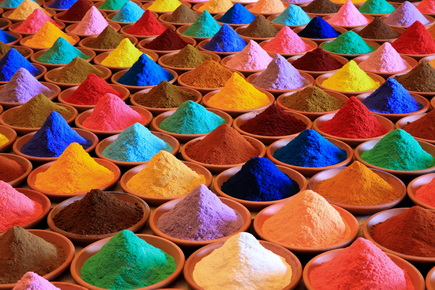August 2025 Update: Kellogg’s will be removing artificial dyes from its breakfast cereals.
June 2025 Update: The food company Kraft Heinz announced it will be working to remove all artificial colors from its food products within the next two years as part of a company-wide shift toward more natural ingredients.

Artificial Dyes in Food and Their Impact on Our Health
Adding colorful dyes to food has been a process used by manufacturers for decades, but do they have any nutritional benefits? The answer is yes, however, very minimal. In fact, their health benefits are so negligible that we can say they have no benefit at all. So why do they do it? The answer is simple – to make the food look more appealing. That said, recent studies have suggested that these food dyes may have a negative effect on our health, especially in children. That is why Health Administrator Robert F. Kennedy Jr. is looking to ban the use of dyes in food by 2026. Let’s delve into the details.
RFK Jr.’s 2026 Plan Explained
Synthetic food colorings are found in a wide range of products, from breakfast cereals to sports drinks. However, RFK Jr.’s concern about them and the health risks they may contain is taking steps to find safer, natural alternatives. In fact, California Governor Gavin Newsom has already taken the initiative to change the policy of adding dyes to food in the state’s schools, as children are considered the most vulnerable to the potential effects of these additives.
Kennedy’s plan is aimed at protecting public health nationwide, as part of a larger effort to make food labeling clearer and more transparent in the U.S.
What Are Artificial Food Dyes and Why Are They a Problem?
Artificial food dyes in the U.S., specifically Red No. 40, Yellow No. 5, Yellow No. 6, Blue No. 1, Blue No. 2, and Green No. 3, are petroleum-based color additives that are used to enhance the appearance of processed foods. While the colors may be eye-catching, they have no health benefits, and increasing evidence suggests that these dyes may have unintended health consequences, including cancer and various other diseases.
Additionally, studies have shown behavioral effects on children, including increased hyperactivity and distraction. This concerns the medical community, as they are fearful that some children may acquire ADHD-like symptoms. Animal studies have also supported behavioral effects after exposure to synthetic dyes.
The Dyes
Red 40 and Yellow 5 are two of the most commonly used dyes. One study examined clinical trials, which confirmed that children can acquire behavioral effects from them, as at least half of them reflected hyperactivity and distraction. In other studies, 52% of the children found significant behavioral associations.
But the most concerning synthetic food dyes were found to be:
Red No. 3 (Erythrosine)
-
-
-
Concerns: Animal studies linked it to thyroid tumors.
-
Behavioral Effects: Limited data in humans, but grouped with other dyes in hyperactivity studies.
-
-
Red No. 40 (Allura Red)
-
-
-
Behavioral Concerns: Associated with increased hyperactivity, restlessness, and inattention in some children.
-
Allergic Reactions: May cause skin rashes or hives in sensitive individuals.
-
-
Yellow No. 5 (Tartrazine)
-
-
-
Behavioral Effects: Linked to hyperactivity, especially in children with ADHD or sensitivities.
-
Allergic Reactions: Known to cause asthma, hives, and other allergic responses in sensitive individuals.
-
-
Yellow No. 6 (Sunset Yellow)
-
-
-
Behavioral Concerns: Implicated in studies showing behavioral changes like irritability and restlessness.
-
Allergies: May provoke allergic reactions, especially in those also sensitive to aspirin.
-
-
Robert Kennedy Jr.’s Plan

Robert F. Kennedy Jr.’s food policy is driven by studies such as the ones mentioned, as well as growing public concern. He aims to reduce or eliminate synthetic dyes in all processed foods sold in the United States by 2026. This effort will collaborate with food manufacturers, retailers, and federal agencies, such as the FDA, to reevaluate safety standards and develop cleaner alternatives.
Kennedy’s administration is also working to include schools. The International Dairy Foods Association has offered to remove artificial colors in school milk, cheese, and yogurt by the 2026 school year.
Food Companies Are Listening
Some food brands are already reducing or replacing synthetic dyes with natural colorings (derived from edible plants, fruits, vegetables, and other natural sources). Companies like Kraft and General Mills have begun transitioning to cleaner ingredients.
What This Means for You and Your Family
If you’re a parent, this move by RFK Jr. could have a significant impact on your family’s diet. As artificial dyes are phased out, you’ll see cleaner food labels, fewer synthetic additives, and an overall push toward safer food for children.
In the meantime, you can start making informed choices by checking ingredient labels and opting for foods labeled “no artificial colors” or “naturally colored.”
Looking Ahead: A Healthier Food Future
Kennedy’s plan marks a significant turning point in American food policy. Backed by scientific research and aligned with global health standards, the initiative sets a new standard for regulating food additives in the U.S.
It’s not just about removing colors. It’s about creating a healthier food-consumption environment for current and future generations. By focusing on ingredients that promote well-being rather than just visual appeal, this effort aims to bring American food standards more in line with those of the rest of the world.
As this change unfolds, manufacturers will be expected to comply with these new standards or face enforcement via executive order, and children will benefit the most.
